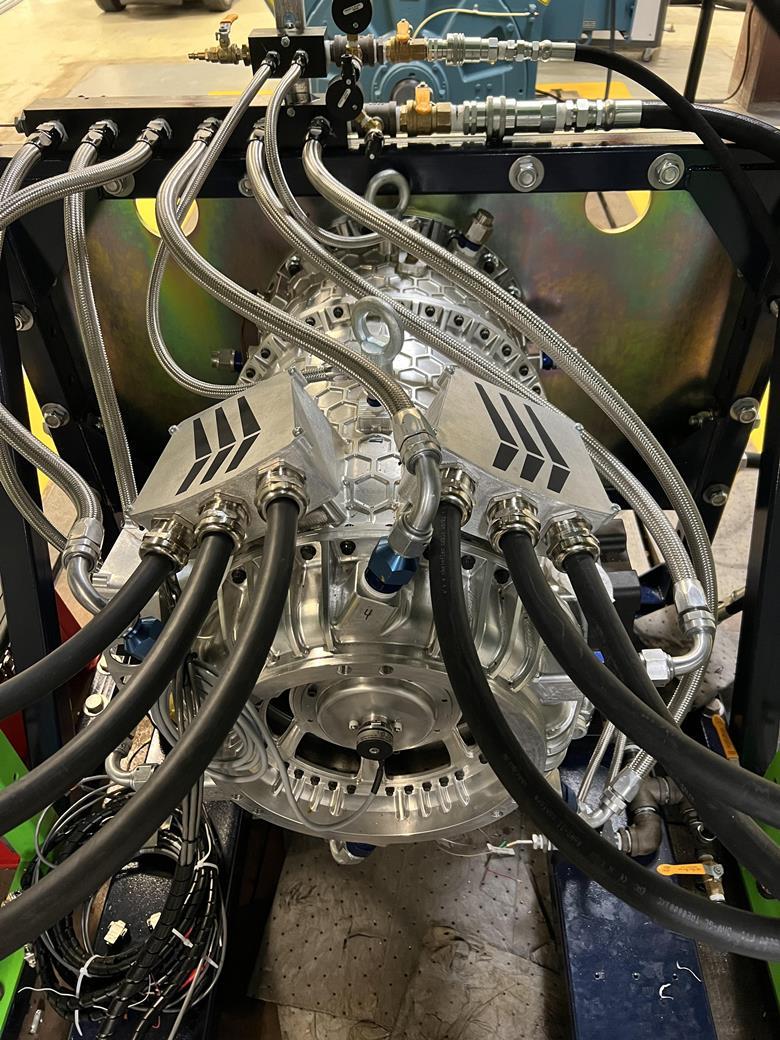Sign up for daily news updates from CleanTechnica on email. Or follow us on Google News!
It has been almost two years since we wrote about Wright Electric and its plan to make an electric airplane that can carry 100 paying passengers on short flights of an hour by 2027. Think an hour is too short? Check out the map below to see all the places you can fly to in an hour or less from London.
The company is working with partners such as easyJet, NASA, Y Combinator, the Department of Energy’s ARPA-E program, and the Defense Department. Back in 2021, the company’s focus was on developing 1 MW electric motors that could provide the enormous power needed to get a fully loaded airplane off the ground and into the air.

Credit: Wright Electric
The company is using a BAe 146 regional aircraft, a four-engine plane originally manufactured in 1983, as its development mule. The plan is to replace one jet engine with its proprietary high output electric motor in 2023, replace a second jet engine with an electric motor in 2024, and then replace all four jet engines with electric motors in 2025. Once all the testing and certification process is complete, the company expects to put the plane into revenue service in 2026.
“Customers are demanding cleaner options and we want to show there is an alternative,” says Jeffrey Engler, CEO of Wright Electric. “A retrofit airplane is always going to suffer from disadvantages but at the same time it’s a certified aircraft.” The certification process for an all new airplane can take years to obtain. Wright is working on its own clean sheet new aircraft, which will carry 186 passengers and have a range of 800 miles (1288 km).
Wright Electric Targets 1000 Wh/kg Batteries
When that story was written, Wright Electric was considering using fuel cells to provide the electricity for its motors. In a press release this week, it said its focus has changed to making lighter, more powerful batteries with a pack energy density of 1000 Wh/kg.
Engler said, “This month, we are beginning our second phase of validation experiments with the approaches that showed the most promise. When I founded Wright, the best vehicle batteries had an energy density below 250 Wh/kg. Now several large manufacturers are advertising cells at double that capacity, and we have visibility into new battery chemistries that could get us to our target of 1,000 Wh/kg.”
Wright’s proprietary batteries would be four times more energy dense than the lithium-ion batteries that power today’s electric vehicles. Such batteries would enable the electrification of hard to decarbonize transportation and mining sectors, and make electric aircraft that can carry 100 passengers possible. Given that the vast majority of carbon emissions in the airline industry are from aircraft with 100 or more passengers, these batteries would enable a paradigm shift in how to reduce or eliminate the carbon emissions from air travel.
Wright Electric has built power-dense electric motors, inverters, and generators for aerospace and defense applications. For example, Wright recently tested its industry leading electric motor with 1 megawatt of power and is planning for altitude testing at the NASA Electric Aircraft Testbed. It also has made a prototype motor with 2 MW of power.

Courtesy of Wright Electric
Unconventional Battery Technologies
Building on this work, Wright is now applying its expertise in lightweight mechanical and electrical systems to battery development. Since 2021, Wright has been conducting experiments with battery technologies that have been overlooked by conventional battery manufacturers. Some battery types are unsuitable for consumer electronics or grid storage, however they could be ideal for applications that require extreme light weight, safety, and compactness.
“We have developed experience building lightweight thermally managed electric propulsion systems, and we see a way to apply that knowledge to the design of large molten battery packs,” says Colin Tschida, who heads powertrain development at Wright Electric.
“To cultivate a breakthrough in energy storage, we engaged four chemistry PhDs to act as scouts for promising battery chemistries,” said Tschida. “This month, we are beginning our second phase of validation experiments with the approaches that showed the most promise.”
Wright is working with multiple academic centers and industry partners to achieve these batteries. Initial packs will be released for laboratory testing in 2025 with the first roll out to aerospace and defense early adopters targeted for 2027.
Molten Battery Technology
In an interview with Flight Global, Engler notes that some cutting edge battery developers such as CATL and Amprius have already hit the 500 Wh/kg threshold. The aviation industry needs batteries with that much energy density to achieve widespread decarbonization and to power all-electric aircraft capable of carrying about passengers on flights of about 600 miles.
“We are looking at different batteries that operate at high temperatures [and] in different form factors, that enable you to get to a higher fraction of active materials in the cell,” Engler said. Traditional lithium-ion batteries are designed to operate best at room temperature and are produced by rolling up a long, flat strip of lithium surrounded by plastic and other supporting material. “Like a “jelly roll,” he added. The lithium that produces the electricity accounts for only about 3% of the weight of a battery for an electric car.
He explained that batteries can deliver significantly more power at higher temperatures. “Molten batteries can have a higher fraction of lithium, or whatever the active materials are. Atoms are more mobile when they’re in a liquid state. Heating the battery up to a molten temperature creates engineering challenges but it also allows us to have high power density and energy density.”
Such batteries would have radically different internal structures. ”A typical battery has solid anodes and solid cathode stacked in a jelly roll shape. Ours has [a] molten anode and molten cathode in two bath tub shapes next to each other. That enables you to increase the fraction of the material that is the active material and therefore reduce the overall weight,” he said.
Decarbonizing More Than Air Travel
High temperature batteries will likely be used first to help decarbonize the mining industry, but could eventually be incorporated into aircraft. Engler added, “They are going to be very good [for] these hard-to-decarbonize industries.” He also said the company’s development of high power electric motors for aircraft has given it expertise in cooling technologies that can apply to batteries.
Wright Electric is now pursuing three high temperature battery technologies and plans to begin testing prototypes in 2025 with deliveries to commercial customers beginning in 2027. The company has not said publicly how the molten batteries would be heated in flight, but suggested the initial heating could take place on the ground prior to takeoff.
So, is flying in an electric airplane in our future? Absolutely. Will it happen before the end of this decade? For the answer to that question, come to our annual New Year’s Eve bash December 31, 2029.
Have a tip for CleanTechnica? Want to advertise? Want to suggest a guest for our CleanTech Talk podcast? Contact us here.
EV Obsession Daily!
I don’t like paywalls. You don’t like paywalls. Who likes paywalls? Here at CleanTechnica, we implemented a limited paywall for a while, but it always felt wrong — and it was always tough to decide what we should put behind there. In theory, your most exclusive and best content goes behind a paywall. But then fewer people read it!! So, we’ve decided to completely nix paywalls here at CleanTechnica. But…
Thank you!
Tesla Sales in 2023, 2024, and 2030
CleanTechnica uses affiliate links. See our policy here.



